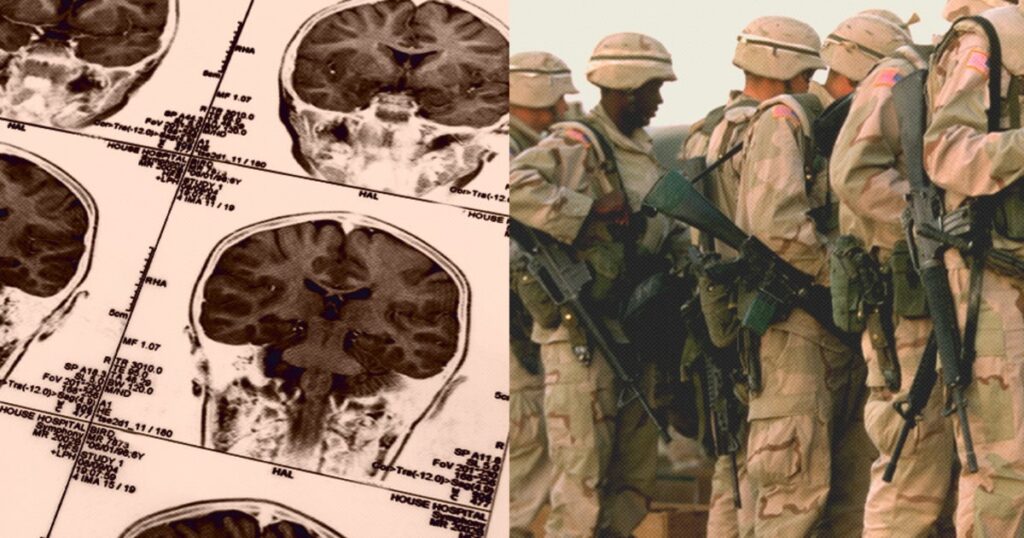

The efforts come a year after the Pentagon’s Office of Inspector General issued a report saying the Defense Department did not consistently identify and assess service members for traumatic brain injuries and did not implement a consistent process to manage the injuries.
Frank Larkin, 68, who was also a Navy SEAL, said while traumatic brain injury was a topic of discussion about a decade before his son died, there has been “very little movement.”
“It’s unacceptable,” he said, “after 20-plus years of persistent conflict.”
‘The science isn’t there’
Symptoms of traumatic brain injury include persistent headaches or neck pain, fatigue, memory issues, trouble sleeping, concentration problems, chronic depression, anxiety and apathy, researchers say.
It can also lead to aggression and violence, experts say, but cases like Card’s that result in mass violence are rare. “These high-profile cases, thankfully, are few and far between,” Stone said. “But they are a point along the overall spectrum — the different ways that the imbalance can manifest.”
Ryan Larkin exhibited many symptoms of traumatic brain injury, his father said. “The changes we saw were uncharacteristic,” Frank Larkin said, adding that his son grew anxious and became short-fused.
Ryan Larkin sought help through the Navy and the VA, but doctors spoke little of traumatic brain injury and focused more on behavioral and psychiatric diagnoses “because that was what they knew,” his father said.
“We are handicapped by the fact that we can only really qualify this post-mortem,” he said.
There is no imaging tool that can detect brain injuries like CTE, Gore said. While some researchers have detected structural white matter changes in the brain, Gore said the method is not yet legitimate or reliable in a clinical setting.
“Right now, the science isn’t there,” he said, “but there’s a lot more that could be done.”
Logging exposure to low-level blasts is a good start, advocates say.
Jon Retzer, who served in the infantry with the Army and then the Army National Guard in the 1990s, said exposure logs should be kept for service members in any role, even when they’re not deployed or engaged in combat.
Hand grenade instructors can cycle through hundreds of trainees in one day during annual or biannual qualifications that are mandatory for some units, according to Retzer, who now works for DAV, an advocacy group formerly known as Disabled American Veterans.
Retzer said the risk of being concussed is higher in certain training scenarios, particularly when trainees are taught to pull the safety pin and hold onto the grenade for a few moments instead of tossing it immediately.
When trainees hesitate for too long, instructors have to throw the grenade over the wall, which causes a close detonation, and then grab the trainee and lower them both to the ground.
“That one has a significant feel to it,” he said. “You can see the dirt actually go right up over, and you can see the wave of dust that was produced.”
There were more than 492,000 traumatic brain injuries, mostly mild concussions, in the military between 2000 and 2023, the most recent year with available data, Defense Department statistics show.
But the total number of cases is likely higher. The current tally, Gore said, does not account for service members who have brain injury from low-level blasts over time.
And if a service member has had more than one traumatic brain injury, only one is counted, according to the Traumatic Brain Injury Center of Excellence, a congressionally mandated collaboration between the Defense Department and Veterans Affairs.
“This isn’t going away,” Frank Larkin said. “And my fear is that this is going to trail behind us for decades.”
If you or someone you know is in crisis, call 988 to reach the Suicide and Crisis Lifeline. You can also call the network, previously known as the National Suicide Prevention Lifeline, at 800-273-8255, text HOME to 741741 or visit SpeakingOfSuicide.com/resources for additional resources.

 Latest Breaking News Online News Portal
Latest Breaking News Online News Portal




